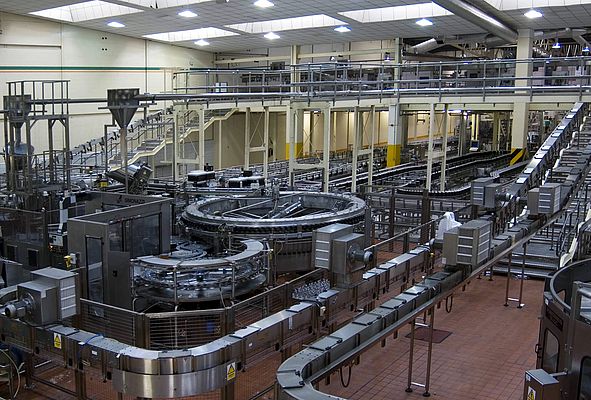Zigbee wireless products provide simple decentralised wireless mesh networks that enable process manufacturers to improve their control and monitoring procedures, achieving end-to-end visibility of production processes, personnel, logistics and distribution operations.
Wireless has always been considered too unreliable for the replacement of traditional fixed cables in process environments. In addition, most wireless networks do not offer the security, robustness and reliability needed for replacing hard- wired telemetry systems.
ZigBee has the potential to overcome these barriers; the technology having been designed to address the market need for a cost-effective, standards-based wireless network, to operate in electrically noisy industrial environments; and, typically, for connecting sensors in remote control and monitoring applications.
ZigBee, like Wi-Fi and Bluetooth, operates over the licence - free IEEE802.15, 2.4GHz frequency band. However, whilst Wi-Fi and Bluetooth have been designed for small networks carrying relatively large packets of information, ZigBee is intended for large networks and lower data rates. This is evidenced by the standard one-milliwatt ZigBee chip, which is short range (70-100 meters) and relatively slow, only 250Kilobits per second.
Another crucial difference that sets ZigBee apart from other wireless systems is that ZigBee/802.15.4 is a full blown telemetry system in its own right, with the ability to provide wireless personal area networking (WPAN) i.e. digital radio connections between computers and related devices, such as sensors. This kind of network eliminates the use of physical data buses such as USB and Ethernet cables.
It also offers key features, including:
1) Acknowledgement that data has been received at its destination;
2) Retransmission in the event of failure due to radio collisions or reflections - in a similar manner to TCP/IP networks.
3) Validation of message content using data sequence numbering (Frame Check Sequence);
4) Network redundancy - such that failure of a node on the network will enable messages to be re- routed via other nodes;
5) Network protocol security encryption.
ZigBee cannot be considered for real time control applications requiring deterministic and fast response times; it has a 10 – 15millisecond network latency when routing messages between nodes within the network. However as ZigBee radio transmissions will propagate up to 100m, it’s unlikely a system will require more than one or two message hops, making the system response time adequate for most remote control and monitoring applications. In addition, the gateway or network co-ordinator can be configured in “beacon mode” to send and receive high priority messages in known guaranteed time slots, called super-frames, for more time critical applications.
Another major advantage of ZigBee for OEMs is that the technology provides an intelligent distributed architecture employing peer- to- peer communications protocol, instead of the traditional master-slave relationships found in standard PLC networks. As a result, ZigBee offers the ability for a network of intelligent modules to communicate and interact with each other, with no requirement for a centralised master controller or PLC.
Whilst a ZigBee network of nodes provides a highly secure, self-healing robust network, on its own the ZigBee stack it is not enough to replace a network of PLCs. What also has to be considered is the control logic, memory and I/O requirement at each node for its own application. IDC’s ZigBee platform addresses this requirement with an OEM module, which provides a complete System –on- Chip (SoC) solution. The ZB100 OEM module is used as the basis for all the ZB product range. It integrates the ZigBee communications stack within a high speed processor and provides an industry- leading C2420 transceiver with 18 configurable general purpose I/O lines for combinations of digital, analogue and serial communication and flash memory, providing a complete system on chip (SoC). In addition, the unit accommodates a wide range of dc supply voltages (4-30vDC) and provides a unique 16- digit MAC address.
IDC supports its ZigBee range of products with complementary software applications including “over- the- air” programming, software development kit using Visual Studio, data logging, remote control and position tracking. Importantly for users of the ZigBee range, IDC are is not reliant on third- party software providers; hardware, application firmware, PC- based software and server applications are all designed in-house by IDC software engineers at the company’s headquarters in Derby.
More About 802.15.4-based ZigBee
The 802.15.4-based Zigbee is designed for remote control and sensors, which are many in number but only require small packets of data, and in the main, extremely low power consumption for long life. The power and flexibility inherent in the technology is exemplified by its ability to support hundreds of devices in star, tree or mesh formations.
ZigBee wireless networking
for process manufacturing environments
- by Intelligent Distributed Controls Ltd
- May 12, 2011
- 823 views


















